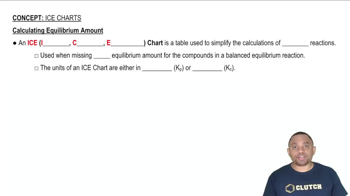Here are the essential concepts you must grasp in order to answer the question correctly.
Equilibrium Constant (Kp)
The equilibrium constant Kp is a numerical value that expresses the ratio of the partial pressures of the products to the partial pressures of the reactants at equilibrium for a given reaction at a specific temperature. For the reaction involving tert-butyl chloride, Kp = (P_CH2=C(CH3)2 * P_HCl) / (P_CH3C(CH3)2Cl). A higher Kp indicates a greater tendency for products to form at equilibrium.
Recommended video:
Equilibrium Constant Expressions
Partial Pressure
Partial pressure is the pressure exerted by a single component of a gas mixture. It can be calculated using the ideal gas law, where the total pressure is the sum of the partial pressures of all gases present. In the context of the question, the partial pressures of isobutylene and HCl are crucial for determining the equilibrium state of the system.
Recommended video:
Partial Pressure Calculation
ICE Table (Initial, Change, Equilibrium)
An ICE table is a tool used to organize the initial concentrations or pressures, the changes that occur as the system reaches equilibrium, and the final equilibrium concentrations or pressures. This systematic approach helps in calculating the equilibrium concentrations of reactants and products by tracking how the system shifts in response to changes in conditions, such as temperature or concentration.
Recommended video:
ICE Charts and Equilibrium Amount




